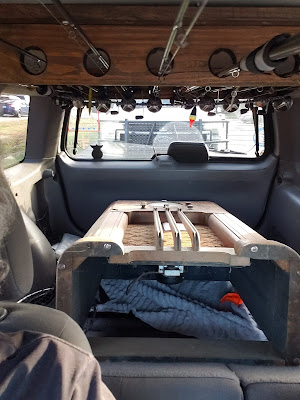This is a multi-part series on the restoration of a 1936 Sparton Broadcast & Shortwave floor model radio. I was fortunate to find this in the condition it was in. Everything was intact, and it only had one piece of veneer broken. The owner bought it 50 years ago to restore, and even had the piece of veneer that was broken, in an envelope with the radio. He said since he had it 50 years, he figured he wasn't going to get around to restoration, so he put it up for sale. Debbie AC4QD is into crafting and furniture restoration, and decided she wanted to do the woodworking aspect of this, so here we go! Below is a pic of it, after transported to the shop. What a beautiful beast!
Below, you see the Sparton in the back of my little Ford Escape, making it's journey to our workshop. It was pretty solid, and only had a few loose wood joints, scratches, etc. A few of the knobs are incorrect, and one piece of broken veneer. The glass face, though very dirty, is in great shape with no cracks or scratches! The speaker is original, and looks to be in good shape. Amazing, for a 88 year old radio.
Below, the electronics are solid! All there, not hacked all up or damaged, just needs restoration. I'll replace all of the old paper/wax caps, probably most of the resistors, clean the chassis / tubes / tube sockets and test the tubes, replace the rubber bushings in the tuner deck, etc. Typical electronics restoration of that era.
We're removing all of the various bits in preparation for repairs to the cabinet and refinishing. Pulling the grille cloth panel, large dial lens, electronics, chassis spacers, magic eye tube mounts, etc. We're gonna try to hand wash the grille cloth in Woolite and cold water, and press dry....maybe it'll work. Otherwise, we'll have to search out some aftermarket cloth.
Next, we got the veneer repaired and ready for leveling (see my chunk of weight to press the veneer during curing?), all of the joints were re-glued and clamped, interior cleaned and ready for a fresh matte black paint coat. Stripping of the old finish comes next. More in Part 2 coming...
Dave WB4IUY

















































